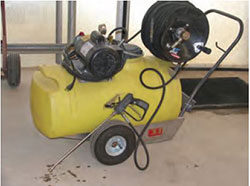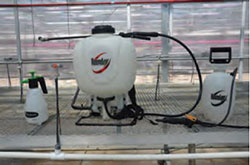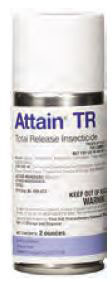by D. Newman*, T. Walker* and J. Craver** (10/19)
Quick Facts…
- Enclosed space production includes agricultural plants produced indoors in structures such as greenhouses, railcars, shipping containers, and more.
- Even with the best integrated pest management (IPM) strategies, pest outbreaks may occur and chemically treating the crop may be the most viable option.
- It is critical to understand the pesticide label and Safety Data Sheet (SDS) before purchasing, storing or using a pesticide.
- Pesticide application methods include sprays (high-volume, low-volume and aerosol), thermal fog, smoke, fumigants and root zone applications.
Enclosed space production includes the production of any agricultural plant indoors or in a structure or space that is covered, in whole or in part, by any nonporous covering that is large enough to permit a person to enter. (CFR Title 40, Part 170.305) Enclosed space production occurs in different types of facilities including greenhouses, mushroom houses, high tunnels, railcars, shipping containers, and warehouses.
Pest Prevention and Management
Pest prevention and management in any enclosed space production facility can be challenging. Integrated pest management (IPM) strategies or enclosed space production facilities should include following sanitary practices, daily monitoring for pest problems, correctly identifying any pest found and determining whether habit modification can mitigate the problem. However, even with the best IPM practices, outbreaks may occur and chemically treating the crop for a pest or disease may be the most viable option. This publication focuses on guidelines for pesticide application, selecting the proper pesticide equipment, and most importantly, keeping everyone safe.
Safe Pesticide Application
If chemical intervention is necessary, it is critical to understand the pesticide label and Safety Data Sheet (SDS) before purchasing, storing or using a pesticide.
Label Information Related to Safe Use
Provide employees with personal protective equipment (PPE) required by the label. PPE includes, but is not limited to, such items as protective suits, footwear, gloves, aprons, respirators, eye wear, and headgear. PPE should be worn as soon as the pesticide is retrieved from storage.
Review First Aid requirements found on the label. It will give instructions on what to do if a pesticide comes into contact with skin, clothing, eyes, or if inhaled. It will indicate what types of exposures require medical attention.
Also review AGRICULTURE USE REQUIREMENTS which is found under DIRECTIONS FOR USE on label. This section of the label refers to the EPA Worker Protection Standard which requires employees to be provided with protections including training, decontamination, notification, emergency assistance, Restricted Entry Interval (REI), and PPE if entry into the enclosed production area is necessary before the REI expires.
Finally, check the label for any requirements concerning ventilation after the application. Proper ventilation is required for enclosed space production structures before allowing workers to enter after some types of pesticide applications. If pesticides are applied as a fumigant, smoke, fog or aerosol or if an applicator is required to wear a respirator then specific ventilation requirements apply.
Safety Data Sheet (SDS) Information
The SDS is a technical bulletin detailing potential hazards for each pesticide by providing workers and emergency personnel with proper procedures for handling the substance. It contains additional information in the event of an exposure, how to deal with a spill and appropriate storage conditions for the product. SDS can be used in combination with a product label but should NEVER be used in place of the actual product label, especially when determining PPE requirements.
Equipment Options
After developing an IPM plan and a safety protocol, review equipment options for the facility. A facility may require several types of application equipment as each has advantages and disadvantages. Pesticide application methods include sprays (high-volume, low-volume and aerosol), thermal fog, smoke, fumigants and root zone applications. The equipment is often classified as a directed sprayer (manually operated, requiring human supervision) or fixed position sprayers (function without direct human supervision). Directed sprayers are more labor-intensive and can result in more exposure for an applicator but can be used for spot applications. Fixed position sprayers require less labor and exposure to the pesticide, but the entire close space production facility will be treated and requires horizontal airflow fans for distribution.
Directed Sprayers

The high-volume hydraulic sprayer is the most common directed sprayer. It is widely used due to versatility and relatively inexpensive to own and operate. It can be used to apply many pesticide formulations and can be used for spot treatments. However, it may produce large droplets which can result in poor coverage.

A cold fogger uses high air pressure to spray out the fogging liquid as fine droplets. The most popular type of cold fogger is the ultra-low volume (ULV) which uses a low amount of liquid and carrier. ULV can be adjusted to produce droplet sizes ranging from 5- 50 microns, but since they move with high velocity, distribution depends on horizontal and vertical air circulation. Cold foggers can be used with water or oil-based formulations. However, they produce a practically invisible ‘fog’ which may make it difficult to control the direction and, since people cannot see the fog, they may be inadvertently exposed. Cold foggers may be used as directed sprayer or fixed position if they are set in an auto mode.

Hand-held and backpack sprayers use compressed air to deliver the spray. The tank must be pumped frequently to maintain pressure, and the tank must be shaken to agitate the chemical. The backpack sprayer has either a hand- or battery–operated pump that pressurizes the spray material. Both use a wand equipped with a nozzle to direct the spray at the target pests.
Fixed Position Sprayers
Fixed-position sprayers are placed inside the enclosed space production area where they function without direct human supervision and include low-volume and ultra-low volume sprayers.

The thermal pulse-jet fogger can be used very effectively with pesticides that vaporize with heat. Thermal foggers generally produce smaller droplet sizes than cold foggers, averaging 0.5-10 microns in size, but the droplet sizes are usually inconsistent and may vary from 0.5-30 microns. Thermal foggers are equipped with a heat barrel that is heated to higher temperatures using either gas (usually propane) or electricity. A liquid fogging solution is pumped into the heat barrel where it is vaporized. This produces a thick fog which is easily visible so fog can be adjusted to the target and there is less risk that people will be inadvertently exposed.

Air-assisted electrostatic sprayers create a positive electrical charge on the spray droplet as it leaves the nozzle. Plants naturally have a negative charge that attracts these positively charged droplets, resulting in successful coverage and effectiveness. The initial investment can be costly, but this system provides less drift than other low-volume sprayers while providing good pesticide distribution.

The mechanical aerosol generator uses air-atomizing nozzles with air supplied by an air compressor to disperse the pesticide into small droplets. Horizontal air flow fans and other movement systems are used to distribute the aerosol throughout the growing space. While air currents within the greenhouse can affect pesticide distribution, mechanical aerosol generators provide favorable distribution and deposition, especially to upper leaf surfaces.

Ready-to-use aerosols, sometimes referred to as total release products, are pressurized canisters that produce a chemical fog when activated. They are ULV systems that may require multiple cans, depending on the size of the enclosed production space. If multiple canisters are used, care must be taken to begin releasing the product farthest from the exit and working backwards.
Non-Sprayer Options
There are other options for pesticide application that do not involve the use of a sprayer. Chemigation and ebb and flow are root-zone application systems that apply the proper amount of a pesticide at the appropriate time to the target area in a safe, effective, and uniform manner. However, not all irrigation systems are suitable for applying pesticides. States generally have additional “use requirements” for chemigation systems, in addition to those on the pesticide label.

Chemigation is the application of any chemical through irrigation water. Chemigation system designs can vary, ranging from periodic injection with a manually controlled system to a continuous-flow solution monitored by sensors.
The ebb and flow system uses shallow, molded plastic channels for delivery. The pesticide solution is pumped from a central storage tank onto the water-proof bench. A series of channels helps to move the pesticide or water quickly so that wetting the media is done uniformly. When application is complete the remaining solution is pumped back into storage tanks where it is held until the next treatment. However, this type of application can produce a substantial amount of wastewater.





